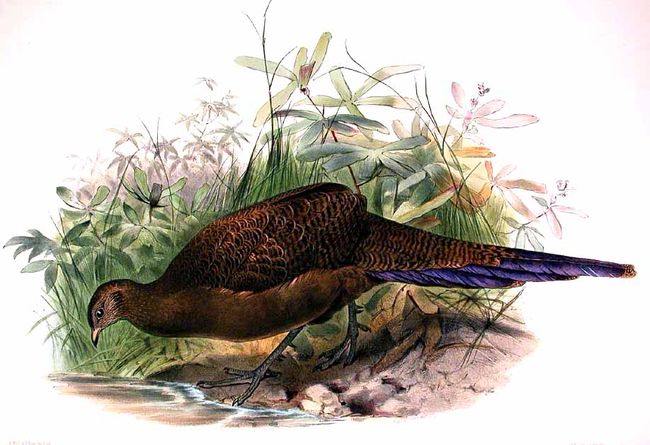- Bronze-tailed Peacock-pheasant
Taxobox
name = Bronze-tailed Peacock-pheasant

status = LC | status_system = IUCN3.1
regnum =Animal ia
phylum =Chordata
classis =Aves
ordo =Galliformes
familia =Phasianidae
genus = "Polyplectron "
species = "P. chalcurum"
binomial = "Polyplectron chalcurum"
binomial_authority = Lesson, 1831
subdivision_ranks =Subspecies
subdivision =
* "P. c. chalcurum" Taxobox_authority | author = Lesson | date = 1831 Southern Bronze-tailed Peacock-pheasant
* "P. c. scutulatum" Taxobox_authority | author = Hoogerwerf | date = 1941 Northern Bronze-tailed Peacock-pheasant
synonyms ="Chalcurus chalcurus"The Bronze-tailed Peacock-pheasant, "Polyplectron chalcurum" is also known as the Sumatran Peacock-pheasant. It is an
Indonesia nbird .Description
The Bronze-tailed Peacock-pheasant is a small, up to 56cm long, dark brown
pheasant with dark grey legs, rather small head and long, narrow tail of sixteen feathers. The tail feathers are chestnut brown with metallic purplish bars near tips. Both sexes are similar. The male has longer tail, two spurs on legs and yellow iris while the unspurred female's is dark brown.Taxonomy and evolution
The Bronze-tailed Peacock-pheasant belongs to the family
Phasianidae and the genus "Polyplectron ", which consists of seven peacock-pheasantspecies . There are two subspecies:
* "P. c. chalcurum", described by Lesson in 1831, which is known as the Southern Bronze-tailed Peacock-pheasant.
* "P. c. scutulatum", described by Hoogerwerf in 1941, which is known as the Northern Bronze-tailed Peacock-pheasant.mtDNA cytochrome "b" andD-loop as well as the nuclearovomucoid intron G data confirms that this species belongs to aclade together with theMountain Peacock-pheasant , but also the mainland speciesGermain's Peacock-pheasant andGrey Peacock-pheasant (Kimball "et al." 2001).The molecular data suggests - though not with high confidence - that this species diverged relatively recently from ancestral Grey Peacock-pheasants. This is quite spurious, since
biogeography , its peculiarly derived plumage, and the fact that it is an insular mountain endemic indicate it is derived from a comparatively smallfounder population ; this would confound molecular analyses. What seems clear is that the present species evolved from mainland Southeast Asian stock, probably during theLate Pliocene toEarly Pleistocene (3.6-1 mya [Note that themolecular clock calibration method used by Kimball "et al." (2001) is now known to be inappropriate, yielding far too low estimates in galliform birds.] ). The loss of ocelli thus is, contrary to long-held opinion, anautapomorphy , and the southern species of this clade - formerly separated in the genus "Chalcurus" - are probably not each other's closest relatives.Distribution and habitat
An
Indonesia n endemic, the Bronze-tailed Peacock-pheasant inhabits to mountain forests of westSumatra .Behavior
As with other member in the
genus , this elusive bird is shy and very wary. But unlike otherpeacock-pheasant s, it has noocelli . Unusually for Galliformes, pairs of this species move around together not only on foot, but also in the air, in the manner ofdove sFact|date=February 2007.Conservation
The Bronze-tailed Peacock-pheasant is evaluated as Least Concern on the
IUCN Red List of Threatened Species.References
* Database entry includes justification for why this species is of least concern
* Kimball, Rebecca T.; Braun, Edward L.; Ligon, J. David; Lucchini, Vittorio & Randi, Ettore (2001): A molecular phylogeny of the peacock-pheasants (Galliformes: "Polyplectron" spp.) indicates loss and reduction of ornamental traits and display behaviours. "Biol. J. Linn. Soc." 73(2): 187–198. [http://www.ingentaconnect.com/content/els/00244066/2001/00000073/00000002/art90536 HTML abstract]Footnotes
External links
* [http://www.birdlife.org/datazone/species/index.html?action=SpcHTMDetails.asp&sid=275&m=0 BirdLife Species Factsheet]
Wikimedia Foundation. 2010.
